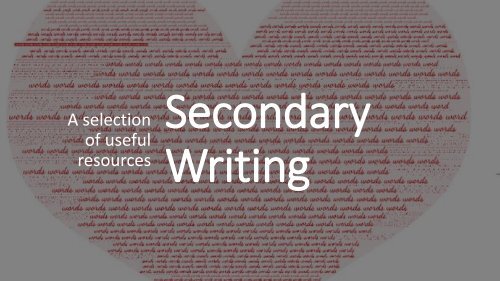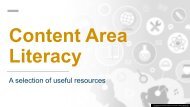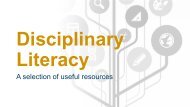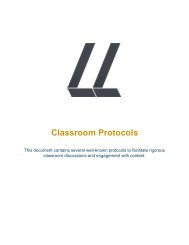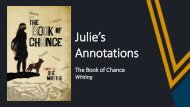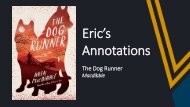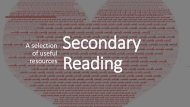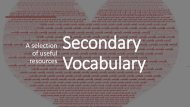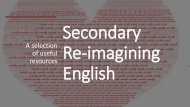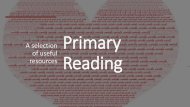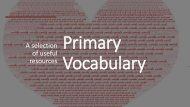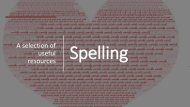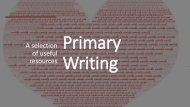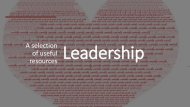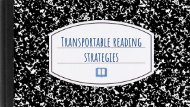Secondary - Writing Magazine 2021
Create successful ePaper yourself
Turn your PDF publications into a flip-book with our unique Google optimized e-Paper software.
A selection<br />
of useful<br />
resources<br />
<strong>Secondary</strong><br />
<strong>Writing</strong>
Teach <strong>Writing</strong> Well:<br />
How to Assess <strong>Writing</strong>, Invigorate<br />
Instruction, and Rethink<br />
Culham (2018)<br />
This book shows you how to assess and teach writing in a way<br />
that’s practical and achievable.<br />
Part 1 walks you through the traits of writing and their key<br />
qualities, showing step by step how to read students’ writing<br />
and offer feedback that nudges them forward through the<br />
revision process.<br />
Part 2 focuses on instruction, offering specific guidance for<br />
how to use what you’ve learned from reading student writing<br />
to design lessons that scaffold students toward making their<br />
own craft decisions and revisions. In addition, there’s an<br />
entire chapter devoted to mentor texts that you can use to<br />
model traits and key qualities for your students.
Hidden Gems: Naming and<br />
Teaching from the Brilliance in<br />
Every Student’s<br />
Bomer (2010)<br />
This book focuses on building teacher capacity to name and<br />
notice the strengths in student writing.<br />
Bomer discusses the importance of the admiring lens and<br />
provides advice on giving effective feedback to students<br />
including:<br />
• spot hidden stylistic gems in writing that are<br />
unconventional or vernacular<br />
• uncover content and organisational gems even when<br />
you don't find the subject matter engaging or<br />
significant<br />
• respond by naming and celebrating writers' gems<br />
instead of hunting for mistakes
Notebook Know How: Strategies<br />
for the Writer’s Notebook<br />
Buckner (2005)<br />
This book shows teachers how to transform the Writer's<br />
Notebook from just a place to write stuff down, to a vital,<br />
constantly evolving tool for each individual child. From notebook<br />
set up, tips, lessons and questions of whether to evaluate the<br />
notebook, Buckner gives teachers a lot to consider.<br />
Some teacher questions Buckner addresses include:<br />
• How do I launch the notebook?<br />
• What mini-lessons can be used throughout the year to<br />
help students become more skilled in keeping notebooks?<br />
• How can writer’s notebooks help students become better<br />
readers?<br />
• How do I assess notebooks?
The <strong>Writing</strong> Strategies Book<br />
Serravallo (2017)<br />
This book has 300 effective strategies for teaching. They have<br />
been grouped beneath 10 crucial goals. This book supports<br />
teachers to:<br />
• provide students step-by-step strategies for writing<br />
with skill and craft<br />
• coach writers using prompts aligned to a strategy<br />
• present mentor texts that support a genre and strategy<br />
• adjust instruction to meet individual needs<br />
• demonstrate and explain a writing move<br />
• provide feedback to young writers<br />
There are suggestion for stocking your writing centre, planning<br />
units of study, celebrating student writing, keeping records,<br />
ideas for anchor charts and examples of student work.
Traits of <strong>Writing</strong>:<br />
The Complete Guide for Middle<br />
School<br />
This book introduces each trait in depth. It<br />
examines samples of students’ writing<br />
looking for evidence of the traits.<br />
This would be a useful book study to build<br />
teacher knowledge of each of the traits.<br />
It is designed for teachers of years 5 - 8<br />
Culham (2010)
Write Like This:<br />
Teaching Real-World <strong>Writing</strong> Through<br />
Modeling & Mentor Texts<br />
In this book, Gallagher emphasises the need for students to<br />
write for real-world purposes. He provides practical<br />
strategies that are based on his own long experience as a<br />
high school teacher, with the purpose of teaching students<br />
to work with specific forms of discourse. These are, express<br />
and reflect, inform and explain, evaluate and judge, inquire<br />
and explore, analyse and interpret, and take a<br />
stand/propose a solution.<br />
Gallagher suggests mentor texts, provides student writing<br />
samples and indicates the sort of assignments that are likely<br />
to grow your student writers.<br />
Gallagher (2011)
Disciplinary Literacy in Action<br />
Lent & Voigt (2018)<br />
This book is highly recommended for teachers and leaders who<br />
are seeking ways to ensure all teachers understand how to teach<br />
literacy in their subjects. The book guides teachers in all subjects<br />
to identify the literacy features of their disciplines, and to use that<br />
knowledge to inform their teaching.<br />
Often differences in disciplines are perceived to be one of<br />
content, but disciplinary literacy recognises that each subject has<br />
its own ways of thinking, reading, writing and speaking.<br />
Furthermore, each discipline has its own forms of writing. For<br />
example, an essay in history is quite different to one in psychology<br />
or geography.<br />
Central to the ideas in this book, is the concept of a whole school<br />
literacy culture where teachers understand the literacy of their<br />
disciplines while also the more general literacy practices that<br />
function across disciplines.
Content-Area <strong>Writing</strong>:<br />
Every Teacher’s Guide<br />
Daniels, Zimelman & Steineke (2007)<br />
Content-Area <strong>Writing</strong> guides you strategically through the two<br />
major types of writing that every student must know:<br />
• <strong>Writing</strong> to Learn and Public <strong>Writing</strong><br />
Daniels, Zemelman & Steineke provide valuable lessons for<br />
encouraging growth in both types of writing with subjectspecific<br />
ideas for planning, organising, and teaching, as well as<br />
samples of student work and guidelines for evaluation and<br />
assessment.<br />
They also include detailed information on how their strategies<br />
fit into the writing process, how they can be used in writing<br />
workshops across the curriculum, and how they prepare<br />
students for testing and other on-demand writing situations.
<strong>Writing</strong> Matters in Every<br />
Classroom<br />
In this book the author provides teachers<br />
with practical information and strategies to<br />
teach non-fiction writing across all subjects.<br />
Peery explains simple strategies and shares<br />
implementation ideas about how writing<br />
can be used in every classroom to increase<br />
success for students.<br />
Perry (2009)
<strong>Writing</strong> Workshops:<br />
The Essential Guide<br />
A valuable resource for developing and maintaining a<br />
writing workshop in the classroom.<br />
The authors lay out each step in the writing workshop<br />
process, including strategies, ideas and the foundational<br />
classroom principles necessary for incorporating successful<br />
writing workshops into each student’s daily schedule.<br />
Each chapter details how a specific component of the<br />
writing workshop looks, functions, and is taught.<br />
Fletcher & Portalupi (2001)
Feedback That Moves Writers<br />
Forward: How to Escape Correcting<br />
Mode to Transform Student <strong>Writing</strong><br />
In this book McGee encourages teachers to resign from<br />
being the Corrector-in-Chief.<br />
She encourages teachers to have a growth mindset where<br />
they view student work formatively and recognise the<br />
positives of student work and provide feedback to students<br />
that meet them at their point of need.<br />
McGee also provides teachers with practical strategies to<br />
support students to discover their own writing identities,<br />
understand their next steps and be prepared to take risks to<br />
achieve their writing goals.<br />
McGee (2014)
Literacy Continuum:<br />
A Tool for Assessment, Planning &<br />
Teaching (Expanded EDITION)<br />
This expanded edition enables teachers to<br />
construct a common vision for student<br />
achievement that effectively and efficiently<br />
engages all students in the robust, authentic and<br />
meaningful literacy learning.<br />
It also provides a way to look for specific evidence<br />
of learning from foundation to grade eight, and<br />
across eight instructional contexts.<br />
Fountas & Pinnell (2016)
Better Learning:<br />
Through Structured Teaching<br />
Describes how teachers can help<br />
students develop stronger learning skills<br />
by ensuring the instruction moves from<br />
modelling and guided practice, to<br />
collaborative learning and finally to<br />
independent tasks.<br />
By: Fisher & Frey (2013)
Texts and Lessons for<br />
Content-Area <strong>Writing</strong><br />
This is the third in Daniels & Steineke series of Texts and<br />
Lessons books - this time helping teachers of any subject to<br />
enhance their students’ ability to understand and write<br />
about texts and topics.<br />
Daniels & Steineke have compiled more than 50<br />
reproducible mentor texts, 36 ready to use lessons, and<br />
more than 200 options for meaningful, extended writing<br />
projects.<br />
This resource has three main sections: two are in your<br />
hands; the third is online.<br />
Steineke & Daniels (2016)


